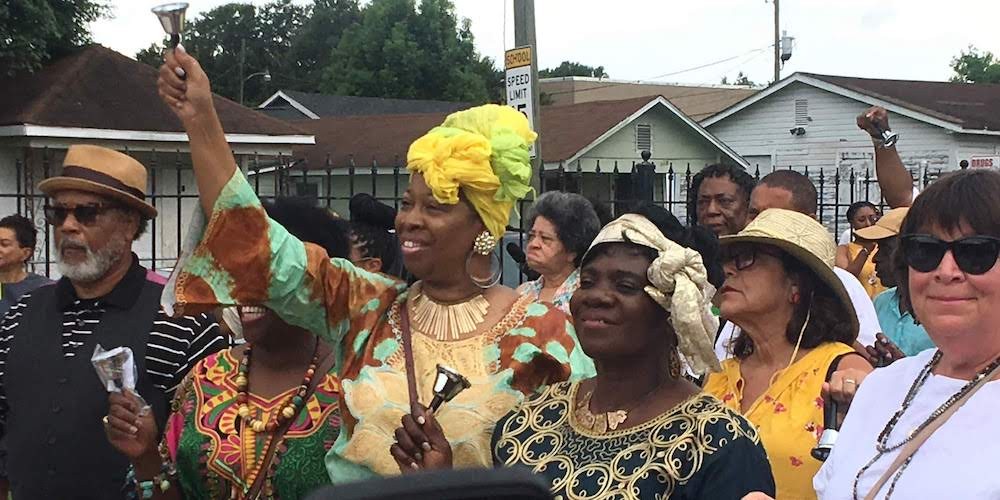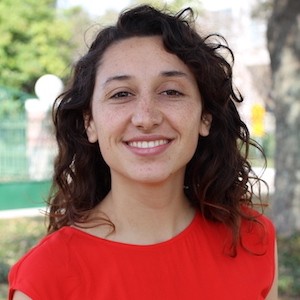Writers in Collaboration: The Story of the Listener
Writers in Collaboration is a series covering writers involved in two art mediums and/or working with other artists. This week we sat down with current nonfiction student, Vera Carothers, whose work as an oral historian deeply influenced how she tells her own story.
We are all collectors of each other’s stories, but this is especially true for current nonfiction writing student Vera Carothers. If you tap into Carothers’ rich pinata of memory, other people’s stories come tumbling out, stories gathered from her oral history career for StoryCorps, the Coney Island History Project, and her latest project, a Spoke Media podcast series, Family Ghosts. So many incredible stories they can sometimes crowd out her own. This was one of a number of things we talked about when we recently met in Dodge Hall. Carothers illuminated for me the transformational process of the spoken word into narrative, and the advantages and limitations of both forms of storytelling.
First, her own narrative: She was a junior at Brown University when she landed a summer job at a small grassroots housing development organization that advocated home ownership for low-income families in Olneyville, a working class area of Providence. Using neighborhood stories, resident interviews in their homes, archival materials, and photographs, she and a coworker created a collective portrait of a place in transition.
Deeply grounded in a documentarian’s discipline of accuracy and context, Carothers will also tell you that Olneyville was an enclave of Polish, Ukrainian, Irish and Italian immigrants attracted to the city’s once thriving mills and jewelry factories in the 50s and 60s. It became in the 80s home to mainly Latinx immigrants, most from Central America, and today, artists are fast gentrifying the loft spaces of the abandoned mills.
It was this project that provoked Carothers’ own writing career. “I wrote a piece drawing on some of these interviews and collected images from the city archive and images people gave us, assembled this history of Olneyville and wrote about it: I wrote about the history of the river, the river overflowing and flooding.”
Other stories tumble out: Like the story of Gabriel Alegría, a jazz musician and bandleader of the Afro-Peruvian Sextet who Carothers met when she was working for the Coney Island History project that sought to collect an oral history of the fabled Brooklyn neighborhood. Alegria was inspired by the “tinny” sounding speakers booming throughout the neighborhood in the summer, that turned “every block you walk down [into] a different beat.” Or Teresa Genaro’s extensive research into the racing tracks of Brooklyn.
The trove of stories Carothers amassed during her stint with StoryCorps' mobile unit as a facilitator of Spanish-language interviews, was enormous—350 interviews, sometimes 4 or 5 conducted over a day. Over the course of a year she and a three member team traveled to 10 different cities from, Providence, RI, Fort Meyers, FL, Lexington, KY, Baltimore, MD, Buffalo, NY, to Mobile, AL in the middle of the seismic political shift into the Trump administration and bore witness to the stories coming out of the heart of America. This time of “paranoia” was a period most fraught for her.
Uniquely equipped as a Spanish language facilitator, Carothers grew up in a bilingual home in Bethesda, Maryland; her mother is native Argentinian, her father American. So, she got to hear many Spanish language stories from immigants during this stressful time. Unfortunately, many of the interviews she conducted, part of the Historias Initiative, which collects stories of Latinx people living in the United States, remain untranslated because of a lack of resources. Others are archived at the Library of Congress and the University of Texas at Austin in the Latin American collection.
There was one story that Carothers said “haunted her.” Maria de los Angeles Costilla walked three hours from her home in rural Alabama to get to the StoryCorps interview so she could tell her story, of how in the 1990s when she was in her 20s she crossed through Loredo, Texas to get into the US. “The person helping you could leave you to die in the middle of the river. There’s no one else to help you, no one to hear you scream…There are a lot of things left behind on the riverbank…”
In such close listening, hearing the stories of violence and trauma is difficult, yet ultimately inspiring. “People would come in and talk about very tragic things that happened to them, but there was always this kernel of hope and resilience so even though I was daily encountering people who had experienced very tough things but instead of [falling] into these traumatic experiences…[there] was always an angle of self preservation…I felt very hopeful about humanity after that job, which was helpful at that time because it was a time of extreme paranoia and fear because of the political climate in 2016-2017.”
Before deciding on Columbia’s MFA program, Carothers considered journalism school because of her strong reporting skills and inclinations, but ultimately decided on the more creative pursuit that Columbia’s School of the Arts offers. Also, there is the question of where the real story resides—what is voiced or what remains silent? Stories, Carothers tells me, are embedded in the atmosphere and circumstances under which they are told, in the chit chat that happens around them, or in the silences. “The process of collecting that audio has made a bigger impression on me…the process of collecting…”
“The medium through which we tell our stories…how we transmit our truth...there may be limits to that…When you’re in the conversation it’s more like the feeling you have around the conversation because there is so much emotion surrounding what you are saying.” All of this, she reminds me, cannot be captured by the spoken word alone.
For example, Rick Mancuso who grew up in Olneyville who, Carothers recalls, “was just a really vivid storyteller and I remember sitting on his porch as he was telling us stories, his voice is just seared in my memory the cadences of his speech. He was talking about how the river was in his blood, hearing about the mill in the morning. He was very optimistic about Olneyville; he saw it as a microcosm of America, how the landscape keeps changing but [is] able to absorb all these differences.”
What she remembers most is the experience of the interview, an insight into speech and memory. “My mind does not pull up a transcript of the conversation. Sometimes I will record or note in a journal but it's often warped immediately by emotionality and very hard to remember. Sometimes you bring up a transcript of what happened and what was said, but it doesn’t convey what I thought was being said, or what was really communicated.” One of the differences between oral history and writing is the ability to supply that.
That’s where the process of editing and selecting is an art form. StoryCorps takes a lot of license with how they shape stories because they record between 40 and 60 minutes of conversation and they whittle it down to about 2.5 minutes. And sometimes those pieces come from all over the longer conversation. So Dave Isay, founder of StoryCorps, talks about “composing with someone else’s words, he talks about audio sonnets.” So the selection process and collaging of different elements is key.
“When you are editing audio, you listen to it over and over again, and the voices get stuck in your head.” Active, sympathetic listening, being present when people are talking about intimate things, takes an inordinate amount of concentration, and emotional presence, but can be emotionally taxing and rejuvenating at once. Carothers tells me that she is now more attentive to keeping the boundaries distinct between herself and her narrators.
During her StoryCorps experience Carothers kept notebooks. “I wanted to write at least one sentence for each story I recorded…I gave myself a space to process what was happening…but I didn’t want to try to capture it in any one particular way…So the small amount of personal space I had was in those sentences, so I think that that year was about other people’s stories. At the same time…it just felt that I was living through them.”
That space is necessary. Being in intimate contact with people reliving trauma, listening to “these really hard stories” as Carothers terms it, can have the same deadening effects on oral historians as on mental health professionals. Learning to reweave boundaries between herself and other people has been key, as well as re-integrating the different parts of herself as well. Writing about her experiences is helping her to do that.
“I’m trying to work on a personal piece this semester exploring the actual colliding of the reporter lens and the oral historian lens vs. the personal lens and [I] just [keep] breaking that open.” In this way the listener becomes the storyteller as her story moves to the forefront.
Carothers’s latest project, a 3-part series for the narrative storytelling podcast, Family Ghosts, came about because of a story she heard while with StoryCorps about Africatown an area in Alabama where descendants of the last slave ship, the Clotilda, still lived. The schooner carrying 110 people docked in 1860, years after slavery was outlawed because of a bet businessman Timothy Meaher made that he could do it. When the remains of the Clotilda were dredged up recently, Carothers, who was going into her second year in the MFA program, went down to Alabama to report, write, and edit segments that would eventually become the initial production of Spoke Media’s series. Listen to it here. Carothers' moving segments follow a group of descendents in their attempts to connect with the Meaher family, still prominent in the area.
Carothers’s story merges with that of her narrators’ stories in interesting and unexpected ways. “My first submission this semester was mostly about working on the podcast, the moments of intimacy I experienced with people I met in Alabama and my questioning of what those experiences meant. All of this is bringing me to a much more personal space of interrogating my motivations for doing this kind of work and my motivations for seeking out that kind of intense human contact. [I’ve been] exploring what sources of alienation or loneliness or outsiderness in my life have led me to crave these connections.”
Carothers interrogates herself honestly. “How much am I able to hear their story and really connect with it and share it in a way that makes connections across cultural differences, people from very different walks of life from me with very different experiences?” She is examining the roots of intimacy using the essay.
There cannot be a storyteller without a listener, and Carothers, trained documentarian and professional listener has maintained a scrupulous professional reticence between herself and her narrators. Now she finds herself wanting to break through to her own voice and become more fully herself in her writing. Weaving her own story with those of her narrators in a series of essays, she explores questions of intimacy and the collective as she looks at her experiences gathering and honoring the larger American story, to which she has been in service. We can only be grateful she has begun to include the indispensable story of the one who listens.

